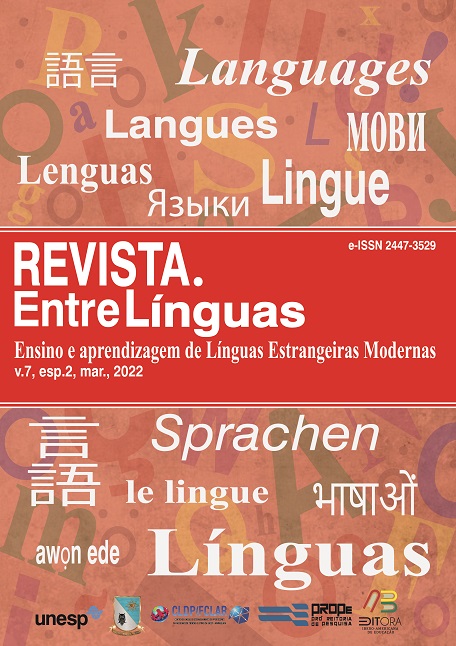Estratégia do hemisfério direito e consideração do perfil lateral como tecnologia inovadora para o ensino de russo como língua estrangeira a estudantes chineses
DOI:
https://doi.org/10.29051/el.v8iesp.2.17324Palavras-chave:
Cognitive style, Functional asymmetry of the two cerebral hemispheres, Right-hemisphere educational strategy, Russian language, Chinese studentsResumo
O estudo é relevante devido ao crescente interesse científico pelas especificidades do pensamento e dos estilos cognitivos das civilizações ocidentais e orientais, bem como dos grupos étnicos individuais que compõem essas civilizações, na junção das ciências humanas e naturais. Os autores deste artigo consideram a conexão entre um fenômeno psicofisiológico como a assimetria lateral dos hemisférios cerebrais e a abordagem cognitiva no ensino de russo como língua estrangeira. De acordo com o estilo cognitivo, o pensamento oriental se refere ao hemisfério direito, enquanto o pensamento ocidental se inclina para o hemisfério esquerdo, o que cria uma situação de conflito cognitivo-acadêmico no processo de aprendizagem. O artigo aborda a solução dos problemas apontados causados pela insuficiente consideração das características etno-psico-fisiológicas de tais alunos. O artigo fundamenta a tese de que os chineses podem dominar o conhecimento, desenvolver várias habilidades e competências usando a estratégia de aprendizagem do hemisfério direito, respeitando a teoria da assimetria funcional dos hemisférios cerebrais.
Downloads
Referências
AZIMOV, E. G.; SHCHUKIN, A. N. Novyi slovar metodicheskikh terminov i ponyatii (teoriya i praktika obucheniya yazykam) [The new dictionary of methodical term and concepts (the theory and practice of teaching languages)]. Moscow: IKAR, 2009.
BADDELEY, A.; GATHERCOLE, S.; PAPAGNO, C. The phonological loop as a language learning device. Psychological Review, v. 105, n. 1, p. 158-173, 1998.
BIM, I. L. Lichnostno-orientirovannyi podkhod – osnovnaya strategiya obnovleniya shkoly [The personality-oriented approach as the main strategy of renewing school]. Inostrannye yazyki v shkole, n. 2, p.11-15, 2002.
KABARDOV, M. K. Kommunikativnye i kognitivnye sostavlyayushchie yazykovykh sposobnostei: Individualno-tipologicheskii podkhod [Communicative and cognitive components of language skills: individual-based and typological approach]. 2001. Thesis (Doctor Degree in Psychology) – Moscow, 2001.
KHROMOV, S. S.; SHUTOVA, M. N.; NESTEROVA, T. V. Linguodidactic framework of teaching russian intonation to a multinational audience in light of experimental data. Revista EntreLinguas, v. 7, n. 2, 2021. DOI: 10.29051/el.v7iesp.2.15140
KULIKOVA, O. V. Neirodidakticheskii podkhod kak faktor povysheniya kachestva obucheniya inoyazychnomu professionalnomu obshcheniyu [The neuro-didactic approach as a factor of increasing the quality of teaching professional communication in a foreign language]. Vestnik Moskovskogo gosudarstvennogo lingvisticheskogo universiteta, v. 14, n. 700, 2014. Available in: https://cyberleninka.ru/article/n/neyrodidakticheskiy-podhod-kak-faktor-povysheniya-kachestva-obucheniya-inoyazychnomu-professionalnomu-obscheniyu. Access in: 07 Oct. 2021.
NISBETT, R. et al. Kultura i sistemy myshleniya: sravnenie kholisticheskogo i analiticheskogo poznaniya [Culture and thinking systems: the comparison of holistic and analytical cognition]. Psikhologicheskii zhurnal, v. 32, n. 1, p. 55-86, 2011. Available in: https://publications.hse.ru/pubs/share/folder/ck1rjm89ef/70690998.pdf. Access in: 17 Oct. 2021.
PERSIYANOVA, S. G.; LIU, I. Sopostavitelnyi analiz kineticheskogo yazyka u predstavitelei russkoi i kitaiskoi kultur [The comparative analysis of sign languages used by the Chinese and Russians]. Moscow, 2018.
PERSIYANOVA, S. G.; LIU, S. Grammaticheskie trudnosti dlya studentov iz Kitaya pri izuchenii russkogo yazyka [Grammatical difficulties for the Chinese students learning the Russian language]. Moscow, 2017.
POTAPOV, A. S. Psikhologicheskoe obosnovanie sistemy obucheniya s uchetom lateralnoi asimmetrii polusharii golovnogo mozga [The psychological foundation of educational system on the basis of the lateral asymmetry of cerebral hemispheres]. 2002. Thesis (Doctor Degree in Psychology) – Moscow, 2002.
SHANTUROVA, G. A. K voprosu o razvitii emotsionalnogo intellekta vtorichnoi yazykovoi lichnosti pri obuchenii russkomu yazyku kak inostrannomu v kitaiskoi auditorii [On the issue of developing the emotional intelligence of secondary language personality when teaching the Chinese students Russian as a foreign language]. Pedagogicheskii zhurnal, v. 9, n. 1-1, p. 562-567, 2019.
SHANTUROVA, G. A. Neirodidakticheskii podkhod v etnoorientirovannoi modeli obucheniya [The neuro-didactic approach to the ethno-oriented model of education]. RUDN, v. 2, p. 372-375, 2017.
SHUTOVA, M. N. Trudnosti obucheniya kitaiskikh uchashchikhsya russkomu konsonantizmu [The difficulties of teaching the Chinese the Russian consonantism]. In: MEZHDUNARODNOGO KONGRESSA PREPODAVATELEI I RUKOVODITELEI PODGOTOVITELNYKH FAKULTETOV VUZOV RF, 4., 2020. Annals […]. RUDN-GIRYaP, 2020. p. 864-868.
SHUTOVA, M. N.; JIANG, Y. H. Sopostavlenie russkoi intonatsii i kitaiskogo tona [The comparison of the Russian intonation and the Chinese tone]. Moscow: Gos. institut russkogo yazyka im. A.S. Pushkina, 2018.
Downloads
Publicado
Como Citar
Edição
Seção
Licença

Este trabalho está licenciado sob uma licença Creative Commons Attribution-NonCommercial-ShareAlike 4.0 International License.
Os manuscritos aceitos e publicados são de propriedade da Revista EntreLínguas. Os artigos publicados e as referências citadas na Revista EntreLínguas são de inteira responsabilidade de seus autores.
Transferência de direitos autorais – autorização para publicação
Caso o artigo submetido seja aprovado para publicação, já fica acordado que o(s) autor(es) autoriza(m) a UNESP a reproduzi-lo e publicá-lo na EntreLínguas, entendendo-se os termos “reprodução” e “publicação” conforme definição respectivamente dos incisos VI e I do artigo 5° da Lei 9610/98. O artigo poderá ser acessado pela rede mundial de computadores (Internet), sendo permitidas, a título gratuito, a consulta e a reprodução de exemplar do artigo para uso próprio de quem a consulta, desde que haja a citação ao texto consultado. Essa autorização de publicação 328 EntreLínguas, Araraquara, v. 1, n .2, p. 323-328, jul./dez. 2015 não tem limitação de tempo, ficando a UNESP responsável pela manutenção da identificação do(s) autor(es) do artigo. Os artigos publicados e as referências citadas na Revista EntreLínguas são de inteira responsabilidade de seus autores.











